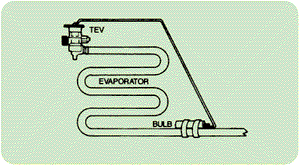To do this, it keeps the coil supplied with the proper amount of refrigerant to maintain the right superheat of the suction gas leaving the evaporator.

TEV operation
Figure 1 shows how it works. At point A, hot, high-pressure liquid refrigerant enters the TEV.- At B, cold, low-pressure liquid plus flash gas enter the evaporator.
- At C, the entire liquid refrigerant has been boiled off or vaporized by the heat load (latent heat).
- Between C and D, the vapor temperature increases dramatically as further heat load is applied (sensible heat). At this point, the gas is superheated above its saturation temperature.
- At D, the suction line temperature of the superheated gas is monitored by the sensing bulb, which signals the TEV to open or close accordingly.
Because good superheat control is the criterion of TEV performance, accurate measurement is vital.

How to measure superheat accurately
Measuring superheat involves four steps, shown in Figure 2.Step A: Determine the suction pressure at the evaporator outlet with an accurate gauge. If there is no gauge connection, a tee installed in the valve’s external equalizer line can be used.
Step B: Refer to a temperature-pressure chart for the refrigerant used in the system, and determine the saturation temperature at the observed suction pressure.
Step C: Measure the temperature of the suction line at the remote sensing bulb location. This can be accomplished by a strap-on thermometer or an electric device similar to an “Annie” or “Simpson” meter.
Be certain the spot chosen for measurement is clean to help ensure accurate readings.
Step D: Subtract the saturation temperature determined in Step B from the suction gas temperature measured in Step C. The difference is the operating superheat.
Which valve to use
Some service technicians seem rather uncertain as to when to use an internally equalized thermostatic expansion valve and when to use an externally equalized one.Our experience has shown that an externally equalized valve should be used whenever pressure drop through the evaporator reaches:
- 3 psi in a 3-ton (or 3-hp) air conditioning system (evaporator temperature range of 30° to 50°F);
- 2 psi in a 2-ton commercial refrigeration system (evaporator temperature of 10° to 30°); or
- 1 psi in a 1-ton low-temperature system (evaporator temperature of 0° or below).
On this basis, an externally equalized valve would automatically be the selection for any system in excess of 3 tons, regardless of the application.

Where to place the bulb
Good temperature feedback to the TEV is vital for control. Place the bulb where it will provide the best possible feedback.Figure 3 shows the ideal placement (horizontal) of the bulb in relation to suction line size. Never put the bulb at 6 o’clock because it may sense the temperature of the oil flowing through the pipe, rather than the temperature of the refrigerant.
Finally, be sure the bulb location is on a free-draining suction line.
Choosing the proper TEV for the specific system remains the first step in good service — and no callbacks.
Publication date: 08/21/2000

Report Abusive Comment